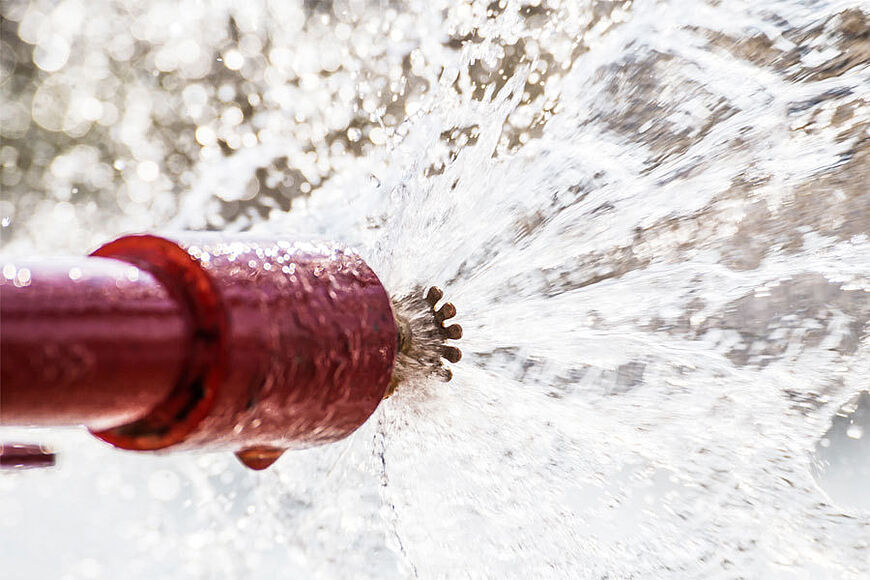Fire Protection Spray Nozzles

An Introduction to Applications & Considerations
In 2013, factory workers in Gainesville, Florida, were caught surprised when a bundle of scrap plastic suddenly caught fire. Due to the highly combustible nature of the chemicals found in the plastic the facility produced, experts say that the fire likely would have quickly grown to engulf the entire 100,000 square foot facility, endangering both the business and the lives of employees. Luckily, the building’s fire protection spray nozzles activated soon after the fire began, snuffing out the danger and avoiding this worst-case scenario.
More than simply a testament to fire protection, this example demonstrates just how important the quality of your fire protection spray nozzles can be in an emergency. Here, we’ll explore a few of the most important considerations to take into account when choosing your own fire protection system that will help you select the best approach for your application.
Consideration #1: Regulatory Requirements
There are many industries which have their own unique set of fire safety regulations which must be adhered to at all times. When selecting your fire protection system be sure you know which specific regulations you have to meet in order to remain compliant and choose a system which helps you meet those. Failing to meet those requirements can mean a complete, forced shut down of your business, or the invalidation of any insurance claims you may have in case of an accident.
Consideration #2: Misting vs Drenching Systems
Fire protection nozzles can take the form of either drenching (sprinkler) or misting systems. The correct one for your needs may depend on several factors, a few of which are outlined below.
Drenching Systems
Drenching systems are more conventionally recognized throughout the United States. Their main purpose is to spray water or any other flame-retardant substance in large volumes to put out the fire and stop it from spreading to other regions or rooms.
The National Fire Protection Association (NFPA) considers the most effective drenching system as those which are capable of delivering no less than 10 liters per minute per square meter, assuming only typical combustible materials are present. If your facility uses highly volatile materials, such as those in the plastic manufacturer example above, greater volumes of suppressant will be required. Fire protection nozzles used in this type of system will need to be capable of meeting those requirements at a moment’s notice.
This type of fire protection is best used in applications where water collecting on the floor is not a concern, and your products are water resistant.
Misting Systems
A main benefit of misting solutions is that they use finely atomized water to suffocate the fire and do not cause any moisture to collect. Accordingly, they are highly popular in applications with electronic equipment like computers and are quickly replacing halon gas fire extinguishing systems. Additional benefits in terms of cost, human safety, and environmental friendliness are the main drivers behind this changing preference.
By producing a fine mist which is then evaporated by the heat of the flames, the water vapor displaces the oxygen in the air, snuffing out the fire. However, in order for these systems to work effectively, the water droplets must be very small so they can evaporate quickly.
Consideration #3: Choose Nozzles With a High Flow Rate
Due to the demands associated with generating adequate fire protection, high flow rate nozzles are key to quickly producing the large volumes of liquid needed.
While there are several nozzle types which are able to produce the necessary water quantities, tangential flow full cone nozzles provide some unique benefits. Lacking the swirl inserts typical of many other fire suppression nozzles, tangential-flow full cone nozzles are not prone to clogging while still retaining the ability to produce extremely uniform distribution of sprayed liquid.
Deflector plate nozzles are also a great non-swirled option that are VdS approved for firefighting applications. Make sure you talk to an expert about whether your chosen fire protection system is capable of delivering a high enough flow rate to be effective.
Consideration #4: Wide Angle Spraying vs More Pipework
When it comes to covering the full blueprint of your building with complete fire protection, there are really two options: either install more pipes with many nozzle attachments, or use nozzles capable of delivering a wide angle of spray to cover the largest possible area.
Frequently, additional pipework is a costly undertaking which is not worth the investment when other solutions exist. To save yourself the costs and the headache, consider the spray angle capabilities of your chosen fire protection system. Doing so will allow you to determine how many nozzles you will need to create a full-coverage fire protection solution.
Lechler Conclusion
Lechler is more than just a nozzle manufacturer. We provide custom engineered spray solutions, state of the art testing capabilities, fabrication, and refurbishment programs, all to ensure you have the exact right nozzle technology to help you meet all your fire protection requirements and special considerations.
Contact our knowledgeable and trusted team today by filling out our online contact form to get started on your custom nozzle and spray solution.